 Written by Hulet Smith, OT
Written by Hulet Smith, OT
For anyone who needs support while walking and appreciates something simpler, smaller, and easier to transport than a walker, rollator, or crutches, a walking cane could be the perfect solution. The support a cane provides while you’re standing and walking keeps you from tiring as quickly, and the assistance with your balance will help reduce your risk of falling. A cane will decrease the load on the leg opposite the hand holding it by up to 25 percent, which is useful for people recovering from hip replacement surgery, back or lower limb surgery, and leg injuries as well as those who have arthritis, and back pain that inhibits mobility. Measuring correctly for a cane ensures it will serve the user correctly. Height adjustability and weight capacity should be part of the decision making process when you’re buying a walking cane. This guide will explain the differences, pros, and cons of the types of cane designs and handles.
For maximum safety and optimal function, it’s important to choose the correct cane for your needs. This will be determined by your functional level. Choosing the correct cane will help you maintain the best possible walking posture and provide protection from a fall injury.
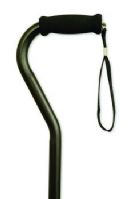 | Offset Handle Aluminum Cane View Product |
The most commonly used canes, straight canes are also known as walking sticks, straight-handled canes, single-end canes, T-canes, C-canes, standard canes, and walking aids. They have a single shaft and one-point base. Most people have successful experiences with a single-tip cane, and users can choose from handle styles, grips, and base tips. Lightweight and durable, the cane’s shaft is usually made of aluminum, plastic, or wood. The handle and grip can be chosen from a long list of options for comfort and to prevent hand slippage. Some can be folded for easy transport when not in use. Different types of tips include rubber for stability, ice-picking to walk in snow or ice, and self-standing so it will stay upright even if you lose your grip. People who need some additional stability or unloading of weight from one side of the body benefit from using a straight cane. Shop for straight canes here.
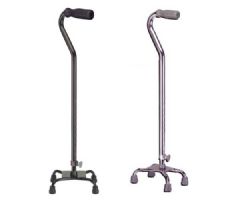 | Drive Medical Height Adjustable Small Base Quad Canes View Product |
A quad cane is similar to a regular straight cane, but it has four small feet extending from the base that make it more stable. It can handle more weight bearing and increases the base of support and stability. This design, which can be purchased with a small or a large base, is an advantage when navigating stairs. Also, when you sit or need to free your hands, the cane stands by itself so you don’t have to bend down to pick it up. This kind of cane is especially helpful for seniors and anyone affected by vertigo, partial paralysis, hemiplegia, stroke, or who are recovering from hip or knee replacement surgery. Also called a 4-prong cane, shop Quad/Three Point Canes to see Rehabmart’s selection of multi-point canes.
A tripod cane works similarly to a quad cane, but it only has three legs on a triangular base. For people with an active lifestyle that includes a lot of time walking outdoors, this design is a good choice for walking over a variety of indoor and outdoor surfaces including grass, gravel, and trails. Also called a 3-point cane, a 3-prong cane, or a cane with three feet, a tripod cane provides more stability and postural steadiness than a standard cane. Its base is wider, but not so wide as to be a tripping hazard. Shop for Rehabmart’s Quad/Three Point Canes here.
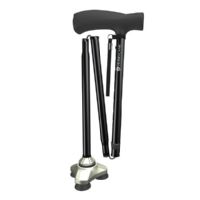 | Drive Medical HurryCane Folding Walking Cane View Product |
A folding cane is used like a standard cane, but it can fold down to a compact size when not in use. This foldability is typically due to multiple joints that can be unlocked. Some of them fold segments into smaller sizes and others collapse into themselves (like a telescope). Like standard canes, folding canes offer a selection of handles/grips and colors. A folding cane is a good choice for someone who is mobile enough to be out and about a lot and wants a cane that will fold up into a purse or other storage carry bag. They are lightweight for easy transport, but durable enough for everyday use. See our Folding Canes for sale here.
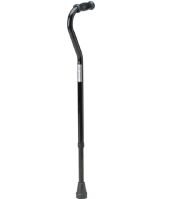 | Offset Handle Bariatric Cane by Medline View Product |
For people with larger frames who have limited mobility, a bariatric cane can support users weighing between 300 and 700 pounds. Most standard canes can accommodate users weighing up to 300 pounds. Weight gain is common for people as they age, and can affect their ability to safely get around. Bariatric canes serve seniors, those with arthritis, and people who are rehabilitating after an injury. Also known as heavy-duty canes, they are usually quad canes.
Shop Rehabmart’s Bariatric Canes here.
The handle can determine the amount of stress on your joints. Handles can be designed for comfort or they can be designed for style. Some are designed for both. Consider how you’ll use the cane, and which hand you’ll be using when you lean on the cane. The best choice for you can help prevent hand numbness and pain that using the wrong handle can cause.
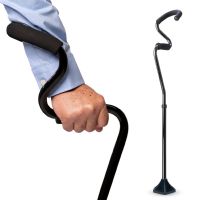 | StrongArm Comfort Cane - Self Standing Support View Product |
People who need extra support when walking typically spend a lot of quality time with their mobility assistance device, and canes are no different. For this reason, ergonomic handles are a huge boon, as they allow the cane to function as a natural extension of the user’s arm, and minimize the discomfort that often comes with holding onto the same piece of equipment for several hours each day. Specially designed to offer added stability and support for the user’s forearm, this handle style helps to alleviate the symptoms of a number of different conditions, such as carpal tunnel and arthritis, and generally offers a more comfortable fit and an easier grip for the user’s hand.
 | Offset Handle Aluminum Cane View Product |
An offset cane handle has a more ergonomic grip than a standard crook handle. Via the bend in the cane shaft, these handles are positioned over the length of the shaft, allowing for even weight distribution along the shaft. With the weight centered, pressure is taken off the hand and wrist. These padded handles reduce strain on your wrist and provide a comfortable grip, coming in multiple styles and shapes.
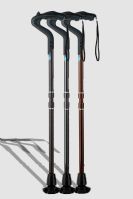 | Ergoactives Ergocane 2G with Ergonomic Grip Handle View Product |
Walking canes with orthopedic handles reduce the stress on the hand and wrist. They provide the most comfort for users who have arthritis, hand weakness, or other conditions that can make it difficult or painful to grip the handle of the cane. Usually made of plastic or gel, these handles are shaped to alleviate more pressure from the hand. These are very popular with seniors, as prolonged cane usage can cause wrist strain.
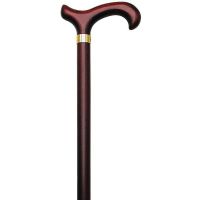 | Wood Derby Cane with Rosewood Stain View Product |
Practical and elegant, a derby cane handle is characterized by its distinctive hook. The small hook at the end of the handle can be hung on the edge of a table or over your elbow to free up your hands without having to drop the cane. Carrying the user’s weight over the shaft and offering great support for the hand, derby handles allow for supreme balance and support.
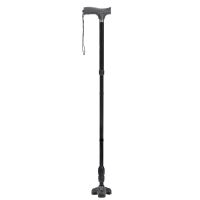 | Drive Medical Flex-N-Go Superior Stability Walking Cane View Product |
A Fritz handle can be used on a variety of canes, including single tip canes, folding canes, and those made of just about any material. They resemble the letter T when viewed from the size, and were designed by a German Count in the 1700s to make using a cane more comfortable for someone with arthritis. This open-ended styled handle allows for more room for the user’s fingers, and the slight curve rests comfortably in the palm. Sometimes this kind of cane is called a crutch handle cane.
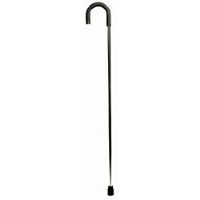 | Aluminum Adjustable Walking Cane View Product |
A tourist handle is also known as a crook or a “J” handle cane, a shepherd’s cane, or a hospital cane.These canes are commonly used to help alleviate general pain from standing and walking. They also are counted on to assist with balance. They are simple and traditional and very common.
The palm grip-style is an ergonomically designed molded cane handle that evenly distributes body weight over the surface of the handle. This means it’s hand specific, and is crafted to specifically fit either the right or left hand. With their perfect fit within the palm, these cane handles are one of the most popular contoured ergonomic handles. This handle doesn’t stress the fingers, hand, or wrist. This style is also good for people who reside in humid climates and those who sweat significantly, as the tight grip isn’t compromised by moisture. This handle is also very durable.
.png&newwidth=365&maxheight=200) | Drive Medical Fixed Height Cane with Seat View Product |
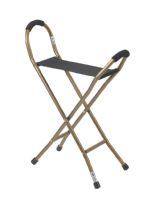 | Drive Medical Folding Cane Sling Seat View Product |
For anyone who enjoys venturing out and wants to accommodate the need to stop and rest, a walking cane with a seat is a game changer. Also called a walking cane chair or a seat cane, this type of cane greatly contributes to mobility and independence. The seat eliminates barriers by making longer outings possible and comfortable for cane users.
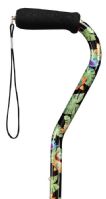 | Carex Designer Offset Pattern Cane View Product |
Ladies walking canes are often more decorative than functional. This doesn’t mean the shaft is weak, but the overall design is often more focused on how a cane looks rather than how it functions. As a result, they come in a wider range of colors and style options.Ladies walking canes are generally lighter than canes designed for men, making them easier to lift, move, and lean on for women. Shop our list of beautiful Designer Walking Canes.
Wood walking canes are a traditional choice and remain a favorite of users. They are strong and durable, exhibit the beauty of natural wood, can meet the needs of almost every application, and are an affordable choice.
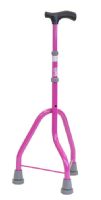 | WalkEasy Pediatric Tripod Cane View Product |
Special needs kids need special equipment designed just for them. Pediatric canes come in colorful designs and are found with one, two, or three feet. Multi-foot (three- or four-feet) pediatric canes provide additional support for youngsters who might not have the strength and coordination to use a single-point cane. Also called a child cane or a kids walking cane, a pediatric cane aids with balance and stability for kids with mobility issues. View and Shop Pediatric Canes at Rehabmart here.
Canes come in a variety of sizes and with many optional features. Choosing a cane that fits your body type, your lifestyle, and your functional needs will maximize the benefits you get from your cane.
The hand that will grip your cane is opposite the leg that needs weight bearing assistance. Some canes are appropriate for use with either hand, but some are specifically designed to best fit a right or left hand. Be sure you get a cane that will fit the hand you’ll be using to grip the cane.
Wood canes are the most traditional. Athough durable, they are the most heavy. Aluminum canes are lighter weight and can be used with foldable canes. Carbon fiber canes are the lightest weight, some weighing less than a pound.
Most cane tips are made of plastic, rubber, or a combination of the two. Maneuvering outdoors over gravel, bricks, cobblestones, or concrete can damage the softest rubber tips, and plastic tips are more durable. Shop all cane tips for sale to see the available options.
Accessories for a walking cane range from convenience to safety options. They include hooks to conveniently hang a cane so it doesn’t have to be picked up off the ground, tips that grip in icy conditions, cupholders, and even flashlights. Shop cane accessories to see what’s available to make using a cane easier and more convenient.
For visually impaired people, the white canes they rely on are easier for users to discern. Other cane styles come in a variety of colors and handles so you can combine the support you need with a look you like, whether that’s attention-getting or something less conspicuous.
Canes are designed to take on about 25 percent of a user’s body weight. Generally, standard canes are built for people who weigh less than 300 pounds. For users with a larger frame, bariatric canes can accommodate people weighing up to 500 pounds.
A: It’s time to start using a cane when you have joint pain when you don’t walk with one, or generally need improved balance and stability while walking
A: A regular cane has just one tip. For people who are at a greater risk of a fall, a four-tipped quad cane provides a base of support that is broader than a single-tip cane. With the additional support, a quad cane is heavier and, compared to a standard cane, can be a bit awkward to lift for people who have hand or arm weakness.
A: If you have an issue on one side of the body, a cane is appropriate. If you have pain on both sides of your body, or weakness in both legs, a walker is a better choice.
A: A standard hook cane typically costs about $15 - $20, quad or folding canes cost $15 - $40, and canes with lots of specialty features like wheels or folding seats cost up to $80.
A: A four-prong cane is called a quad cane.
A: Proper cane length can generally be determined by dividing a user’s height by two. In most cases, the right sized cane is within an inch of half their overall height.
A: The best cane to buy is the one that has the features that meet your safety, stability, and sizing needs.
A: Because of its broader base, a quad cane is the best style for balance.
Since one out of five falls causes a serious injury, reducing the risk of a fall - while maintaining as much mobility as possible - can be achieved by using a cane for walking. A cane enables a user to go farther and walk with less discomfort as it provides support for a weak or injured hip, leg, or foot.
The number of feet, handle design, and grip materials all figure into choosing the correct cane. Although simple wooden crook canes are still very popular, new materials and designs with special features have created lots of purchase options. Shop all canes to see what’s available to meet your specific needs.
Thank you for reading about how to choose the best walking cane. Visit Caregiver University for more useful articles and helpful tips.

Co-founder/CEO of Rehabmart, Pediatric Occupational Therapist, husband, and father. Passionate about connecting special needs kids with superb nutrition, sensory integration, and complementary health strategies. Excited about Rehabmart's mission to become the premier online educational platform which empowers caregivers by spotlighting innovative devices and interventions to achieve optimal patient response and recovery.